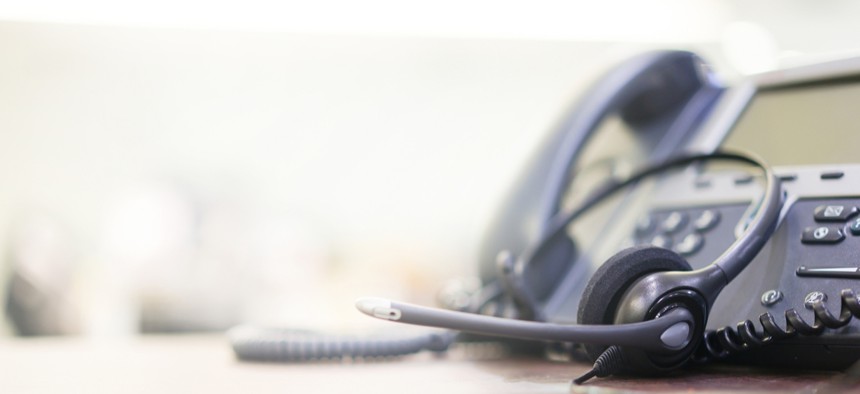Improving Customer Experience in the Wake of COVID-19

chainarong06/Shutterstock.com
During a crisis when it is most important to provide an experience that gives customers confidence in their government.
Over the past month, as COVID-19 cases spread rapidly across the country and normal life came to a screeching halt, many government agencies at all levels and private-sector entities were caught off guard, unprepared for the onslaught of inbound calls from concerned customers. News stories and social media posts described immense frustration as people waited on hold for hours to talk to their county health department about getting tested, or called other county offices to inquire about grants for small businesses, or called their state unemployment office hundreds of times a day without ever being able to get through to file for unemployment benefits.
These overwhelmed state and local government agencies can serve as a cautionary tale for federal agencies—both in the near future, as customers follow up with the IRS or Small Business Administration about CARES Act benefits (and likely future stimulus measures), for example, and longer term, as all agencies look for ways to increase call center resilience and performance in times of crisis. After all, it is precisely during a crisis when it is most important to provide an experience that gives customers confidence in their government.
Beyond expanding physical capacity through the addition of phone lines and staff, there are other steps agencies can take that will not only reduce wait times but also help optimize operational efficiency, customer experience, and strengthen fraud mitigation efforts.
Enhancing the Call Center Experience while Maintaining Security
Fraud is always a concern for call centers, but agencies know they need to be particularly vigilant in times of crisis, when criminals may seek to take advantage of the general chaos as well as opportunities for social engineering presented by call center agents’ natural empathy and the potential lack of clarity in the rules surrounding hastily rolled-out relief programs.
When a customer calls a federal agency, the call center representative must first confirm that the person calling is genuinely who they claim to be. The authentication process generally involves asking the caller to provide personally identifying information such as their Social Security number and date of birth, for example. Unfortunately, this information can be easily obtained by fraudsters. Also, this “brief” task typically takes up the first 30-60 seconds of every call—time that is particularly valuable when the lines are extremely busy.
Agencies often wonder how to achieve the right balance, as relaxing the authentication process will speed up service and reduce costs but increase the risk of fraud, while tightening fraud security measures too much will frustrate callers and increase operational costs. Fortunately, there are technology solutions and best practices that have been proven in the private sector that can help government agencies evolve through this time as well.
Faster, More Accurate Authentication
Initiating an automated authentication process before the call is answered can allow agents to spend more time on high-value service rather than low-value identity interrogation—which has become increasingly unreliable as frequent data breaches have made vast troves of citizens’ personal records, including answers to challenge questions, available to criminals on the dark web.
Authentication methods that confirm the calling device’s legitimacy, determine that the call itself follows the expected routing from one end to the other, and assign a strong authentication token are more robust than knowledge-based authentication and can mitigate common phone fraud risks such as SIM swapping, unauthorized number reassignment, spoofing, call virtualization and call forwarding.
Agencies will likely need to draw on resources beyond their own databases to strengthen the automated authentication process, as customers may call from different phones than the ones they usually use (for example, during the COVID-19 pandemic, small business owners will likely be calling the SBA from home or using their cellphones if their shops or offices are closed). Authentication solutions should continuously corroborate citizen and device identity data against other authoritative data sources to ensure that information is accurate and up to date.
Authenticating more callers within the interactive voice response (IVR) system—as well as ensuring that the IVR call path is both intuitively designed and regularly updated to enable citizens to find answers to questions involving new relief programs—can help contain more callers within the IVR system and reduce pressure on call center agents. And when an agent’s assistance is needed, a shorter authentication process will reduce costs and set a positive tone for the rest of the call, improving customer experience.
As technology continues to streamline more and more transactions in the private sector, customers have less patience when their interactions with government agencies fail to meet the same standards. While the COVID-19 pandemic has no doubt created unprecedented circumstances, crisis preparedness means planning for the unthinkable, and that includes being prepared for a sudden high volume of calls. A quick and automated authentication process for inbound calls can help reduce wait times and enable agents to focus all their efforts on the valuable work of assisting customers during difficult times.
Scott Straub is director of public sector at Neustar Inc.





